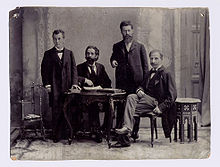Edward Flatau
Edward Flatau (born December 27, 1868 in Płock , Poland ; † June 7, 1932 in Warsaw ) was a Polish medic. Flatau is still one of the most famous Polish neurologists who established neurobiological and neuropathological science in his home country. He supported the establishment of the Neurological and Psychiatric Section of the Warsaw Medical Society and influenced the establishment of the Polish journals Neurologia Polska and Warszawskie Czasopismo Lekarskie .
In 1886 he began his studies in Moscow, where he was particularly influenced by the psychiatrist Sergei Korsakow and the neurologist Alexei Koschewnikow . After graduating in 1892, he came to Berlin in 1893, where he continued his training with Emanuel Mendel , Heinrich Wilhelm Waldeyer , the internists Alfred Goldscheider and Ernst Viktor von Leyden and the neurologist Hermann Oppenheim until 1899.
Flatau shared an interest in neuroanatomy with the Berlin neurologist Louis Jacobsohn-Lask . As early as 1894 he published the atlas of the human brain and fiber structure , which appeared in German, English, French, Russian and, in 1896, in Polish. In 1897 he established the law of the eccentric positioning of the long tracks , which was also the subject of his doctorate in Moscow in 1899, and worked in particular on the pyramidal track , tumors of the spinal cord , multiple sclerosis , meningitis and neurological diseases associated with tuberculosis . With his teacher Alfred Goldscheider, he published the normal and pathological anatomy of nerve cells in 1898 , a work on the structure of nerve cells and their change under mechanical, thermal and chemical influences: the character of the change provided information about the nature of the influences. He defended the neuron theory , which he was particularly interested in since 1895.
Flatau turned down a call to the neurological chair at the University of Buenos Aires and returned to Warsaw in 1899. He set up a private microscopic laboratory in his apartment, worked as a consultant in various Warsaw hospitals and had a large private practice. In 1904 he became head of the neurological clinic at the Jewish Hospital in Warsaw, where he trained numerous neurologists. He designed neurological examination schemes, which he published in Warsaw and Berlin in 1915.
Teaching was very important to Flatau, he encouraged his students and young colleagues intensively. He himself has been described as humble; His motto was a quote from Nothnagel : Only a good person can be a good doctor . In 1911 he set up a neurological laboratory in the Warsaw Psychological Society and in 1913 became the first chairman of the neurobiological department of the Warsaw Science Society, and from 1919 chairman of the Nenski Institute for Experimental Biology. During the First World War, Flatau worked with his friend, the neurologist Samuel Goldflam . He published his best-known book about migraines in 1912 in a Polish and a German edition .
Works
- as an author
- Atlas of the human brain and fiber orientation . 2nd edition. Verlag Karger , Berlin 1899 (together with Emanuel Mendel ).
- Manual of the anatomy and comparative anatomy of the central nervous system of mammals . Karger Verlag, Berlin 1899 (together with Louis Jacobsohn-Lask ).
- The migraines . J. Springer, Berlin 1912 (monographs from all areas of neurology and psychiatry; vol. 2).
- Neuritis and polyneuritis (Handbook of Special Pathology and Therapy; 11, Vol. 3, Dept. 3–4). Verlag A. Hölder, Vienna 1899–1900 (together with Ernst Julius Remak ; Flatau wrote the chapters on anatomy and pathological anatomy).
- 1899. 290 pp.
- 1900. pp. 289-714.
- Normal and pathological anatomy of nerve cells. Based on recent research . Verlag Kornfeld, Berlin 1898 (together with Alfred Goldscheider ).
- Tumeurs de la moelle épinière et de la column vertébrale . Paris 1910. 175 pp.
- as editor
- Manual of the pathological anatomy of the nervous system . Karger Verlag, Berlin 1903/04 (together with Louis Jacobsohn-Lask, Karl Aanders Petrén and Lazar Salomowitsch Minor).
- Annual report on the achievements and advances in the field of neurology and psychiatry . 1899 (together with Louis Jacobsohn-Lask and Emanuel Mendel).
literature
- Ulrike Eisenberg: From “Nerve Plexus” to “Soul Power”. The work and fate of the Berlin neurologist Louis Jacobsohn-Lask (1863–1940) . (Berlin contributions to the history of science; 10). Peter Lang, Frankfurt / M. 2005, ISBN 3-631-54147-3 , pp. 33-34.
- Eufemiusz J. Herman: Historia neurologii polskiej (monograph z dziejów nauki i techniki; Vol. 97). Polska Akademia Nauk, Breslau 1975 (in Polish).
Web links
- Literature by and about Edward Flatau in the catalog of the German National Library
| personal data | |
|---|---|
| SURNAME | Flatau, Edward |
| BRIEF DESCRIPTION | Polish neurologist |
| DATE OF BIRTH | December 27, 1868 |
| PLACE OF BIRTH | Plock |
| DATE OF DEATH | June 7, 1932 |
| Place of death | Warsaw |



